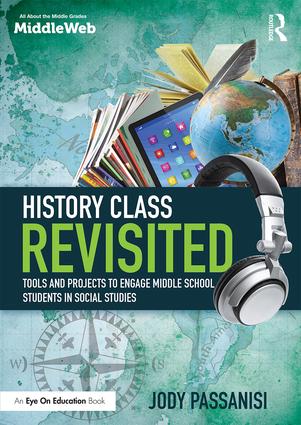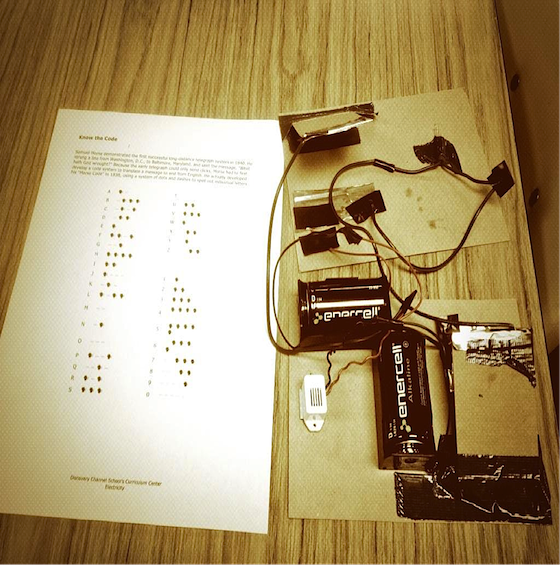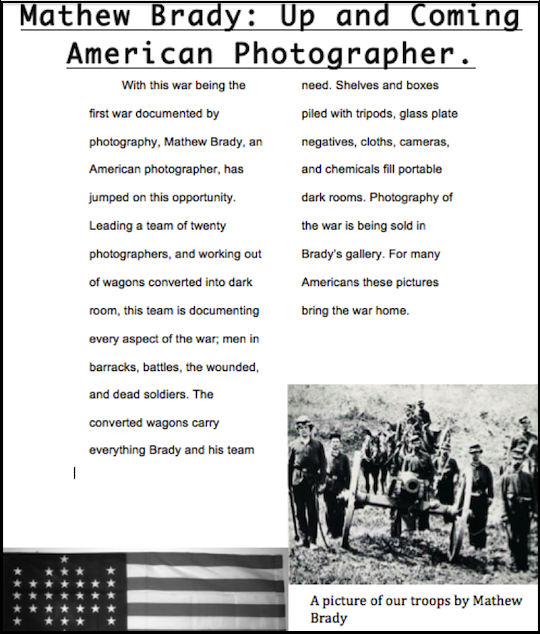Project Learning in History Class
A MiddleWeb Blog
 by Jody Passanisi & Shara Peters
by Jody Passanisi & Shara Peters
The idea behind Project Based Learning is that students will understand more if they make meaning through inquiry based creation. Project Based Learning can apply to any discipline.
We’ve tried it in our history classroom to varying levels of success. Being proponents of constructivism, Project Based Learning was not too much of a stretch for us to embrace, pedagogically. However, there are some challenges that result.
In this blog post we’ll describe two eighth grade American History units (the U.S. Civil War and the Reconstruction Era) in which we incorporated Project Based Learning and share our reflections on those experiences.
Technology and the Civil War
Our Civil War Unit has always been something we weren’t fully satisfied with, so it seemed natural for us to try out Project Based Learning with this unit. We had scaffolded the Civil War extensively with a “Causes of the Civil War Unit” that took months to complete, so students were primed with contextual understanding before beginning this unit.

The students were only given two “rules”: 1) Their projects should fully answer the question and be beautiful, meaningful, sophisticated, and enduring; and 2) They could conduct their research using books or the Internet engine SweetSearch, a search tool that limits results to academically vetted articles and avoids much of the “world wide web” served up by Google or Bing.
Curiosity and engagement
The research and inquiry process was incredible to see. Because the students were able to choose a topic that interested them, there was automatic interest on the part of the students — they were interested in the topic for its own sake. More times than not, students walked in the door to our classroom talking about their project, sat down and immediately got to work before the bell rang, and we did not even have to tell them that class was starting.
Also, the narrow and academically reliable nature of the results on SweetSearch allowed the students to assign more credibility to their search results, spending more time reading for comprehension rather than deciding whether or not to throw out a source. These factors, combined with the space for creativity that was allowed by the open-endedness of the prompt, made for a level of engagement that we have yet to see in any other independent work we have devised.
Examples of student work
Our students created informative and creative presentations that showcased their knowledge to their peers. While there were still the ubiquitous PowerPoints and (now) Prezis, there were also movies, skits, and game shows used as platforms for the students to share what they learned with their audience. One group, charged with conveying how communication changed the war, made a functioning telegraph to show just how quickly messages were sent using this new technology, in contrast to older forms of information transfer.
Another team, also presenting about communication, created a newspaper. In a fairly meta way, they explained how communication affected the people at home. They even included an obituary section and acted out a discussion about the names of the deceased. They showed an understanding both of the content, and more importantly, the impact of the technologies they chose to examine on the American Civil War and on modern war in general.
We had less PBL success during Reconstruction
Our subsequent experience with Project Based Learning for the Reconstruction Era was not quite as successful. Why? We have a few hypotheses. For one, the students did not have as much scaffolding for this unit as they did for their Civil War studies. Without the framing context comparable to what they had for the Civil War PBL assignment, students had difficulty figuring out where to begin their research.
Students seemed to find the concept of the Civil War a little more straightforward than Reconstruction. At the very least, there is an agreed upon beginning and end for the War, whereas even the chronological parameters for the Reconstruction Era are debated. Next time we teach this unit, we plan to provide students with more general context for Reconstruction before they break off into subtopic groups for independent research.
Project Learning pros and cons
There are some definite pros and cons when using PBL for history classes. We can see how this kind of approach might make some teachers, especially those who really feel like certain facts and events must be understood and mastered, go nuts.
The open-endedness of PBL, even with the inclusion of some project guidelines, requires the teacher to yield some control, and that is going to be a challenge for some of us who are more accustomed to holding the reins of facts and chronology pretty tightly.
Similarly, since PBL is most often done in teams, it is always possible for issues of work inequity to arise. (We have a system for equal sharing of responsibility in group work that we’ll talk about it in a future post.) However, the amazing creativity, and the spectrum of that creativity, that you see with PBL is definitely worth giving up some of the control. And the student investment in the material cannot be understated. Isn’t that what we want — for the students to really engage and care about this stuff? Another plus: Because of the nature of PBL (choice, student interests, teaming, etc.), differentiation and multiple modalities are built into its construct.

How about you? Have you tried PBL in your classroom? What’s worked? What’s been a challenge?





































Would you mind posting your project instructions and rubric? Thanks.
Thank you for your analysis and sharing. I’m curious about the differences between your Civil War and Reconstruction units: what was the exploratory question for the Reconstruction PBLs and will you modify it next year? Thanks again for stimulating conversation and ideas.
Being a SS tchr and formally trained in PBL by BIE at pbl world . I wonder if you guys went thru the critical friends protocol? These convos would help in the design process. I think SS is an obvious fit for pbl and use it in every class. Just really need to focus on the process of creating it. ( and I love BIE’s framework! )
I am also a SS teacher who has been highly trained in PBL. I never do a project without critical friends. It’s the crucial turning point from good project to great project.
Great ideas! Students are developing a variety of skills in PBL. How do you assess this skill and knowledge for mid-terms and finals? How long did this project on the Civil War take to complete? I was a history teacher before switching to ESL. PBL gives me some ideas for combining teaching ESL and history. I commend you for creating a blog and sharing your ideas.
Thanks for sharing! Are you two on twitter? Check out #inquirychat and #sschat.
Sure! Because of the nature of the project, the instructions are minimal. The following was up in slide form on the Smartboard for the duration of the research days. We were introduced to this particular rubric in a PBL conference with Gary Stager.
Your task:
Answer this question using your particular technological innovation:
How did your form of technology change the war?
Using SweetSearch, find at least ten sources (look for primary sources as well), to help you to answer this question.
As a team, you will turn in a project showing the results of your work, and will make a five minute presentation.
Your projects should be:
Beautiful
Thoughtful
Personally meaningful
Sophisticated
Shareable with a respect for the audience
@Caleb, the prompt for the Reconstruction PBL unit was:
Create a presentation that answers this question:
You might think that ________was ____________after the Civil War, but really___________.
Use at least ten sources–find them on SweetSearch.
(They had previously chosen elements of Reconstruction)
The idea was to have students reflect on our 21century expectations for Reconstruction and compare those expectations to what actually happened. I think, upon reflection that next year we may focus on the experience of the emancipated African Americans. If you have any suggestions as to how to frame the question for the unit, please let us know.
Thanks!
@deb, great suggestion. We have done the Critical Friends Protocol with other units and projects (our teacher preparatory program–DeLeT–uses it for all lesson and unit planning), but we didn’t use it for this unit. We collaborated with the American history teacher at a nearby high school, and of course, worked together; sharing the unit with the protocol could help improve it, especially Reconstruction. The importance of crafting any unit, PBL or otherwise, should not be underestimated.Thanks again!
@Judith, thanks for your comment. That’s a great question. So far, we have assessed their understanding of the content through open-ended questions that require the students to think critically, but to use evidence to support their ideas. Usually these assessments are short answers to prompts. It’s one of the things we are always looking to improve is the variety and alignment of our assessments. Since we use UBD, the concepts that we want the students to walk away with are related to the enduring understandings of the unit. In terms of skills, we have assessed more through student reflection of the process and applying what they gleaned from the reflection to the next PBL process.
@Joseph, we are definitely on Twitter. Follow us @21centuryteachr.
We have participated in chats in the past, but timing has always been tricky for us. When are the #sschats usually?
At the end of the day if they are still forced to learn about the Civil War while they have divergent interests I’m not sure how this respects students or truly engages them in meaningful learning? Also, PBL may be an excellent choice for many students but there are those who prefer working solo, and some who would prefer to simply receive the information they desire through lecture. The universal usage of PBL while enticing does not meet the needs of all students. Its major flaw is that it retains the notion that an adult knows what subjects and, or skills students must learn in order for the student to reach THEIR goals, this is the major critique of any standardized approach i.e. CCSS as well.
@zep- thank you for reading and for looking so closely at the efficacy of PBL. Agreed- PBL does not necessarily meet the needs of all learners, nor does it satisfy those who would rather listen to a lecture. We aren’t necessarily advocating the use of PBL for every unit; we only use it for two out of our eight units per year. As for the content, it’s true that perhaps some students are not drawn to the Civil War, but it is our job as teachers to present opportunities for students to learn about our country’s past. When creating a curriculum for a history class, one has to make decisions about what to, and what not to, teach. We are, like many teachers, bound to address our state’s standards, and soon, in our discipline, the CCSS. Arguably, the Civil War and its aftermath were incredibly shaping for our country’s ethos- I don’t feel that giving them that kind of focus is too narrowing, but rather combines student interest and teacher direction.
I certainly empathize with the limitations of standards and admire that you are going above and beyond to make the subject as relevant as possible. I have had the privilege of observing a school wherein they are not bound by such parameters and they have what to me is a beautiful process for determining curricula. They have a whiteboard where teachers, students, and occasionally parents/guardians or even outside volunteers can write on either half of the board, things they would like to learn and things they would like to teach. When a small group coalesces around one of the subjects on the whiteboard then the course is taught. These children range from K4-12 grade and all kids are welcome in all courses, obviously a Trig class probably won’t be of much interest to a 3rd grader but they are welcome to come and try it out, nature takes its course from there. Best of luck w/ your endeavors to make school a more enjoyable and relevant place for our youth!
As a high school US history teacher, this really gives me some insight into problem based learning. I’m in my second year of teaching and I am constantly trying to learn new approaches that take the focus off of me and put responsibility into the hands of my students in order to foster a passion for history. Thank you for your help!
Is there a way to see a sample or get some more specifics on the PBL Civil War Project? I am trying something, and am not at all satisfied with where I’m going…
Let’s talk further: please email at 21centuryteachr@gmail.com
Sorry it’s a bit late– would love to give you additional information if you still need it.
I too am interested in seeing a sample or more specifics on the PBL Civil War. I would like to try an idea and I’m not sure how to pull the lesson together. This is very similar to the idea I’m thinking of doing with my students. Any help and/or suggestions is greatly appreciated. I’m very new to the concept of PBL to engage students more fully in their learning, but my first project didn’t go as I had hoped.
Alicia – thanks so much for your interest. You probably noticed that this post appeared in 2013 and has received a lot of comment since. In 2016, Jody Passanisi published her book “History Class Revisited” which includes a long chapter (Chap 8) on project based learning in social studies, including a section about the Civil War unit. We’re sending you some content from that section. If you’d like to review a free copy let us know. It’s also available at a 20% discount here.
I teach at a school that uses an online learning system as its curriculum. My principal wants us to do more blended learning but with three or more subjects in my class at a time I find that very difficult. I am looking for new approaches for next school year and this may just fit for students who do not want to be on a computer ALL day but my concern is for my lower level students, who struggle with comprehension.
Terica– PBL might be a great way to be able to integrate the three subjects. You could come up/have the students come up with an inquiry question to explore in all three realms. It is always a challenge when a lot of the information students encounter may be above their comprehension level– you could help students by searching for comprehensible text– my students love Ducksters, for what it’s worth.
With PBL and and an inquiry question, students have to read and search through content a great deal– though they may need guidance or a checklist of some kind to make sure they are hitting certain marks (depending on what type of content/question you are examining) and comprehending the content they find.
Let’s talk further if you’d like– Twitter @21centuryteachr
Terica– you might also want to check out Aaron’s posts at Future of History– he has a lot of good ideas:
http://www.middleweb.com/tag/aaron-brock/
I teach 8th grade U.S. history and love your PBL examples. Is there a way I could get the lesson plan so I could try to incorporate your great ideas? These pages wont print.
Thanks, Yvonne yjuz@comcast.net
I’m not sure how you cover the standards we are required to teach with this process. You said you spent a month on the causes–we’ve got about a week. And, although I like the technology focus of the Civil War, they would come out of this unit knowing very little about the actual war, its importance, its effects, the struggle of both sides for victory, why the North won over the South…these are all things that are tested on our state test. Maybe you don’t have to give a state test for US History?
The process can be used with any content. If we had a week to look at the Civil War and wanted to zoom out the focus, we might have the students look at an inquiry question like you mention: Why did the North win the Civil War? You could guide the students’ focus where necessary in order to adhere to particular standards, but still allow for the students to do their own exploration as well. We also teach our students around 3 to 3 1/2 hours per week, so the timing is different for us– a month is more like a couple weeks in a classroom with more time. We are also including the Nullification Crisis and the Missouri Compromise in Causes rather than in other units like Jacksonian Democracy or expansion… Hope that helps!
Jody and Shara, I am interested in your book and the Civil War PBL. Is that project in the book?
Hi Kerri,
Thanks for reading! That project is definitely in the book. Would love to hear how it goes!
Best,
Jody
As a parent who is railing against integrated PBL school wide in a combined 7/8 grade environment what I would like to know is how the students are “taught” the content covered by other groups. My child will learn their little piece of the story but what about the rest of it? She starts high school next year and I am terrified by this whole prospect quite honestly.
@Tammy– it’s understandable to have concerns about how students will understand content. I strongly encourage you to read through this article that just came out about the benefits of project-based learning. One of the points underscored is that when students uncover their own understandings of content, that content sticks and allows for connections to be made that wouldn’t be possible otherwise. https://hechingerreport.org/project-based-learning-boosts-student-engagement-understanding/
i hope more people see this.